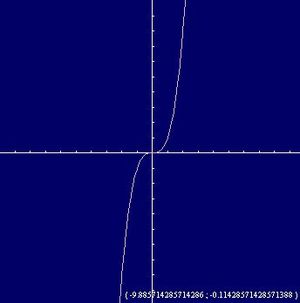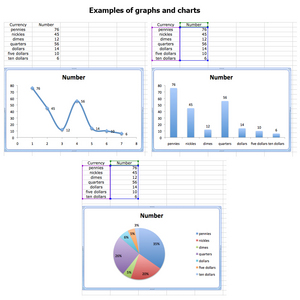There are four types of conic sections, one of which is a parabola. The equations y = ax2 + bx + c and x = ay2 + by + c are equations of the general form of a parabola. A parabola is the set of all points the same distance from a fixed point called the focus and a line called the directrix. The line that passes through the middle of the parabola at the vertex is called the axis of symmetry. The graph of the equation in the form y = ax2 + bx + c will open up if a > 0 and open down if a < 0. The graph of the equation in the form x = ay2 + by + c will open to the right if a > 0 and open to the left if a < 0.
To find the focus and the directrix, think of the equation of a parabola in the form y2 = 4px. We know that this parabola opens to the right. For the equation y2 = x, we know that 4p = 1, therefore p = ¼. We now move p units from the vertex along the axis of symmetry to get the focus. Since the vertex is (0,0), the focus is (¼, 0). The equation for the directrix in this case is x = -1/4 and in general, x = -p for a parabola that opens to the right or left. Note that it’s easy to determine the value of p from the equation. Simply set 4p equal to the number in front of the x in the equation of the parabola and solve. The focus will always be inside the parabola.
The standard form of the equation of a parabola is given by y – k = a(x – h)2 , if the parabola opens up or down and x – h = (y – k)2 if the parabola opens left or right. If a >0, it opens up or to the right and if a < 0, the parabola opens down or to the left. The vertex of the parabola is at (h, k). The focus is p units from the vertex and the directrix is the equation y = k – p or x = h – p depending on how the parabola opens.
Example: Find the vertex, axis of symmetry, focus and directrix of the parabola with equation y = 16(x + 2)2 – 4.
First we must get the equation in standard form so we add 4 to both sides of the equation to get
y + 4 = 16(x + 2)2.
The equation is now in standard form, so we know the vertex is at (-2, -4) because h = -2 and k = -4. Since the equation is in the form y = x2 , the parabola opens up, therefore the axis of symmetry is the line x = -2. To find the focus, recall the equation must be in the form y = 4px2. Since the equation is in that form, we set 4p = 16 and solve for p to get p = 4. Since the parabola opens up, we move 4 units from the vertex along the axis of symmetry. So we move from (-2, -4) to (-2, -4 + 4) = (-2, 0). The directrix is a line 4 from the vertex in the opposite direction. Therefore the directrix is the line y = -8.
Example: Find the vertex, axis of symmetry, focus and directrix of the parabola with equation x = 8(y – 3)2 +5.
First we must get the equation in standard form so we subtract 5 from both sides of the equation to get x – 5 = 8(y – 3)2.
The equation is now in standard form, so we know the vertex is at (5, 3) because h = 5 and k = 3. Since the equation is in the form x = y2 , the parabola opens to the right, therefore the axis of symmetry is the line y = 3. To find the focus, recall the equation must be in the form x = 4py2. Since the equation is in that form, we set 4p = 8 and solve for p to get p = 2. Since the parabola opens to the right, we move 2 units from the vertex along the axis of symmetry. So we move from (5, 3) to (5 + 2, 3) = (7, 3). The directrix is a line 2 from the vertex in the opposite direction. Therefore the directrix is the line x = 3.
Example: Write y = -8x2 + 64x – 130 in standard form and graph it.
Recall that the equation a parabola in standard form is y – k = a(x – h)2. So we first want to subtract 130 from both sides to get y + 130 = -8×2 + 64x.
To get the right side of the equation in standard form of a(x – h)2 , we have to complete the square.
y + 130 = -8(x2 – 8x)
y + 130 – 128 = -8(x2 – 8x + 16) (Take half of the coefficient of 8x and square it and add to both sides. We are adding -128 to the left side because we are adding -8(16) to the right side).
y + 2 = -8(x – 4)2 (Factor the right side)
The equation is now in standard form. We know the vertex of (4, -2). Since the equation is in the form y = -x2, the parabola opens downward. The axis of symmetry is x = 4. To find two other coordinates to plot on the graph, choose values for x. We’ll choose x = 2. Substitute 2 in for x in the equation to get
y + 2 = -8(2 – 4)2
y + 2 = -8(-2)2
y = -8(4) – 2
y = -34.
An easy way to plot another coordinate is take a value for x the same distance from the vertex as the first value. In this case we chose x = 2, which is 2 units from the vertex. So the other value to choose for x can be 2 units from the vertex in the other direction, which is 6. Notice when substituting 6 for x we will also get y = -34. That’s the easy way to plot the second coordinate. The coordinates equidistant from the vertex for a parabola in this form will always have the same y coordinate. So the points to plot to draw the parabolas are the vertex (4, -2) and the coordinates (2, -34) and (6, -34). Then draw the parabola through the coordinates.
This guide should help clear any confusion about recognizing equations and graphs of parabolas.



